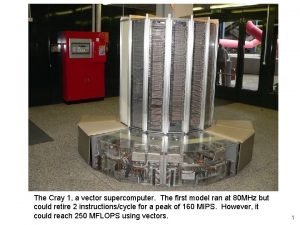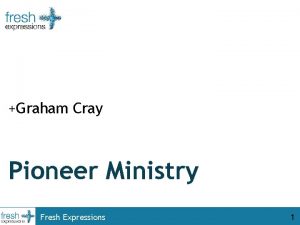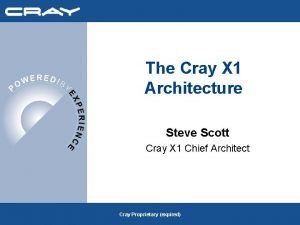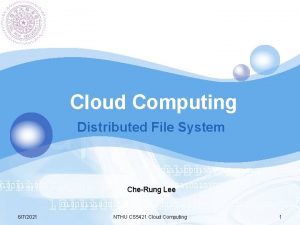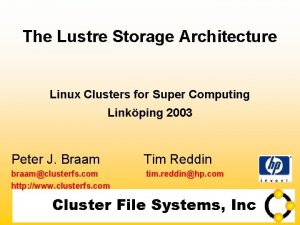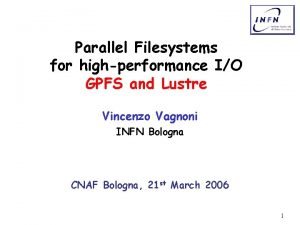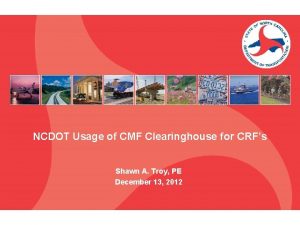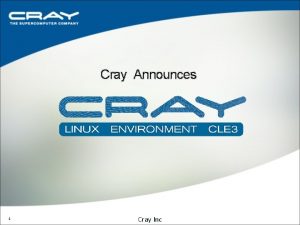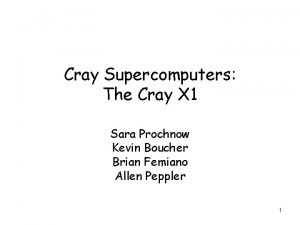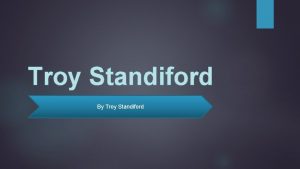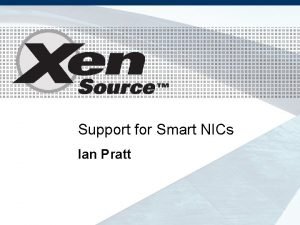NICS Lustre Experiences on Cray XT 5 Troy























- Slides: 23

NICS Lustre Experiences on Cray XT 5 Troy Baer Victor Hazlewood Junseong Heo Rick Mohr John Walsh

NICS Lustre Experience · Overview of NICS and Lustre at NICS · Building the Lustre file system · Question of Purging vs. Quotas · Configuration and Limitations · Canary in the Coal Mine · Wrap Up


Kraken Cray XT 5 Overview · 88 cabinets · 8256 compute nodes (66, 048 cores) – 4416 2 GB nodes – 3840 1 GB nodes · 72 service nodes (48 OSS/1 MDS/23 other) · SMW 3. 1. 10/CLE 2. 1. 50 · Lustre 1. 6. 5 -2. 1. 50 HD


Lustre Overview · MDS server w/ metadata RAID · 48 OSS · 336 OSTs (7 OSTs per OSS) · Infiniband direct connect (no IB switch) · 12 DDN S 2 A 9900 in 6 cabinets · 2. 4 PB formatted / 3. 3 PB unformatted

Building the Lustre File System · All IB rpm’s not identified when we installed · Went through 3 iterations of building Lustre – 380 TB file system – 1. 3 PB file system – 2. 3 PB file system · Format of the entire 2. 3 PB was done in stages by a script. A format of the entire space overwhelmed the MDS

Question of Purging vs. Quotas · “How to manage the space? ” was the big question · Use a purge script? · Turn on quotas? And how to best make use of quotas, if used · Different types of performance impacts depending on purging vs. quotas

Question of Purging vs. Quotas · XT 4 experience showed that walking the file system to identify files to purge was prohibitively slow and degraded metadata performance on the file system to an unacceptable degree · Decided to do performance tests to quantify the impact of quotas just after acceptance of XT 5

Question of Purging vs. Quotas · Three separate tests were run: – A threaded file creation and deletion test on a single compute node – A file-per-process bandwidth test, using the standard IOR benchmark – A shared file bandwidth test, also using IOR · These tests were run in four situations: – Before the file system rebuild – After the file system rebuild with quotas disabled – After the file system rebuild with quotas enabled but not enforced – After the file system rebuild with quotas enforced

Question of Purging vs. Quotas · Threaded file creation/deletion test showed a substantial improvement in MDS performance of the DDN EF 2915 array relative to the LSI RAID boot array used before the rebuild. · The sustained rate of file creation increased by 59% · The sustained rate of file deletion increased by a surprising 718%. · After enabling quotas, these rates did drop slightly, by 12% in the case of file creation and 10% in the case of file deletion.

Question of Purging vs. Quotas · No measured performance impact on file-perprocess I/O by enabling quotas · Write and read performance to a shared file dropped by 6% and 1% respectively · Enabling quotas actually improved write performance by 5% but also decreased read performance by 5%, while enforcing quotas effectively reversed the situation. The maximum impact of quotas observed on shared-file I/O performance was 6%.

Question of Purging vs. Quotas · Results of testing showed – a metadata performance penalty of 10 -12% – a maximum bandwidth impact of 6% · Therefore we chose to move forward with quotas being enabled but not enforced. · We suggest that this small performance penalty will be largely offset by not having to traverse the Lustre file system periodically in order to generate a file purge list and the performance impact that goes with it · However, relies on users to take action…

Configuration and Limitations · Budget constraints limited our configuration which led to some interesting tradeoffs in performance and capability – a minimum number of controllers – high number of OSTs per OSS – large number of Lustre clients (O 8300)

Configuration and Limitations · 30 GB/s demonstrated sustained performance using IOR benchmark. About 5 GB/s per cabinet · No redundant paths, therefore, no failover capability · Ended up with 48 OSS servers, 7 OSTs per OSS

Configuration and Limitations · Tunable parameters changed: – Portals “credits” increased · 512 for compute nodes · 1024 for OSSs · 2048 for MDS – Timeout increased to 250 seconds to prevent timeout, eviction and reconnect looping – Default stripe count: 4 – Default stripe size: 1 MB (users need training on stripe sizing!)

Canary in the Coal Mine · Hardware issues affecting the portals network are not always noticed until Lustre generates errors, generally, followed by user complaints of file system “hang”. Need more user education to address this. · Lustre errors in the logs continues unless the associated hardware issues are resolved, mostly by a system reboot and removal of problematic hardware.

Canary in the Coal Mine · We typically see half million to seven million lines of Lustre error messages a week · Once we separate interconnect failure caused error messages, Lustre messages are predictable and consistent · Failed nodes are identified by the timeout and eviction sequence · Heavy concurrent I/O patterns beyond the current bandwidth limits manifest themselves as a global delay

Canary in the Coal Mine · Coordinating Lustre errors with netwatch log messages usually precedes an HSN collapse · The HSN sometimes recovers by itself eventually ingesting all the portal traffic. · We did see the self recovery twice during last three months. But it tends to have lingering effects and job performances become unpredictable after such recovery.

Lustre Monitoring · Lustre error counter: monitors the Lustre warnings, Errors, and ratio of the two. · Lustre hang sampling: random interval checks on Lustre response time and is logged continuously during production. · Lustre File system state: number of files generated and total disk space used are recorded hourly.

Wrap Up · Lustre seems to provide early warning of system failures both detected and undetected. It is our “canary in a coal mine”. · Quotas enabled but not used seems to provide a decent tradeoff between automated system purging and full quotas. Still have to depend on users to take action. · NICS is iteratively improving our Lustre monitoring with a combination of log watching, Lustre file system response time and file system state


 Nics competency framework
Nics competency framework Nn konnekt
Nn konnekt Cray fish
Cray fish Graham cray
Graham cray Cray 1
Cray 1 Cray cs series
Cray cs series St mary cray primary school
St mary cray primary school St mary cray primary
St mary cray primary John levesque cray
John levesque cray Vector supercomputer
Vector supercomputer Graham cray
Graham cray Cray 1 architecture
Cray 1 architecture Polychromatic luster cataract
Polychromatic luster cataract Lustre vs gluster
Lustre vs gluster Esquema de comutação de escada
Esquema de comutação de escada Lustre architecture
Lustre architecture Lustre file system
Lustre file system Lustre gpfs
Lustre gpfs Lustre quota
Lustre quota Ieso la paz
Ieso la paz Troy sex and the city
Troy sex and the city Troy group, inc
Troy group, inc Troy majnerick
Troy majnerick Cmfclearinghouse
Cmfclearinghouse




